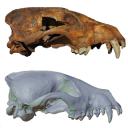3D models of Miocene vertebrates from Tavers
3D models of early strepsirrhine primate teeth from North Africa
3D model of Burmesescorpiops wunpawng
3D GM dataset of bird skeletal variation
Skeletal embryonic development in the catshark
Bony connexions of the petrosal bone of extant hippos
bony labyrinth (11) , inner ear (10) , Eocene (8) , South America (8) , Paleobiogeography (7) , skull (7) , phylogeny (6)
Lionel Hautier (22) , Maëva Judith Orliac (21) , Laurent Marivaux (16) , Rodolphe Tabuce (14) , Bastien Mennecart (13) , Pierre-Olivier Antoine (12) , Renaud Lebrun (11)
MorphoMuseuM Volume 10, issue 02
<< prev. article next article >>

|
Original article : fossil reconstructionThe Fossils of Speothos pacivorus (Carnivora: Canidae) at the Peter Lund/Quaternary Collection of the Natural History Museum of DenmarkJuan V. Ruiz
Published online: 14/05/2024 |

|
M3#1475Holotype of Speothos pacivorus Type: "3D_surfaces"doi: 10.18563/m3.sf.1475 state:published |
Download 3D surface file |
Auler, A. S., 2020. History of research in the Lagoa Santa Karst. In: Lagoa Santa Karst: Brazil's Iconic Karst Region (Auler, A. S., and Pessoa, P., eds.). Springer Nature, 1-11. https://doi.org/10.1007/978-3-030-35940-9_1
Berta, A., 1984. The pleistocene bush dog Speothos pacivorus (Canidae) from the Lagoa Santa caves, Brazil. Journal of Mammalogy, 65(4), 549-559. https://doi.org/10.2307/1380837
Cartelle, C., 2020. Cave Paleontology in the Lagoa Santa Karst. In: Lagoa Santa Karst: Brazil's Iconic Karst Region (Auler, A. S., and Pessoa, P., eds.). Springer Nature, 209-225. https://doi.org/10.1007/978-3-030-35940-9_11
Holten, B., and Sterll, M., 2000. The Danish Naturalist Peter Wilhelm Lund (1801-80): Research on early man in Minas Gerais. Luso-Brazilian Review, 33-45.
Holten, B., and Sterll, M., 2011. Peter Wilhelm Lund e as grutas com ossos em Lagoa Santa. Editora UFMG, Belo Horizonte.
Kohler, H. C., Cançado, A. M., Gomes, D., Macieira, F. L., & Nascimento, N., 1978. Carte du Karst. Laboratoire d’Analyse et Cartographie des Formations Superficielles de l’Université de Caen et le Centre de Geomorphologie, CNRS, Caen.
Lösel, P. D., van de Kamp, T., Jayme, A., Ershov, A., Faragó, T., Pichler, O., ... & Heuveline, V. (2020). Introducing Biomedisa as an open-source online platform for biomedical image segmentation. Nature communications, 11(1), 5577. https://doi.org/10.1038/s41467-020-19303-w
Lund P. W. (1839).Coup d’oeil sur les espèces éteintes de Mammifères du Brésil, extrait de quelques mémoires présentés à l’Académie Royale des Sciences de Copenhague. In: Annales des Sciences Naturelles, 11, 214-234.
Okřinová, I., 2013. Paleoecology of fossil species of canids (Carnivora, Mammalia). Master thesis. Faculty of Sciences, University of South Bohemia, České Budějovice, Czech Republic, 53 p.
Perini, F. A., Russo, C. A. M., and Schrago, C. G., 2010. The evolution of South American endemic canids: a history of rapid diversification and morphological parallelism. Journal of evolutionary biology, 23(2), 311-322. https://doi.org/10.1111/j.1420-9101.2009.01901.x
Prevosti, F. J., Forasiepi, A. M., 2018. South American fossil carnivorans (order Carnivora). In: Prevosti, F. J., and Forasiepi, A. M. (ed) Evolution of South American Mammalian Predators During the Cenozoic: Paleobiogeographic and Paleoenvironmental Contingencies. Springer, 85-136. https://doi.org/10.1007/978-3-319-03701-1_4
Wenzel J., Tarini M, Panozzo D. and Sorkine-Hornung O., 2015. Instant Field-Aligned Meshes. ACM Transactions on Graphics (Proceedings of SIGGRAPH Asia 2015).
Zrzavý, J., Duda, P., Robovský, J., Okřinová, I., and Pavelková Řičánková, V., 2018. Phylogeny of the Caninae (Carnivora): combining morphology, behaviour, genes and fossils. Zoologica Scripta, 47(4), 373-389. https://doi.org/10.1111/zsc.12293